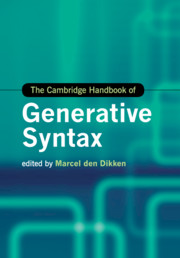Book contents
- The Cambridge Handbook of Generative Syntax
- Series page
- The Cambridge Handbook of Generative Syntax
- Copyright page
- Contents
- Contributors
- Preface
- Part I Background
- 1 Introduction
- 2 Brief overview of the history of generative syntax
- 3 Goals and methods of generative syntax
- Part II Modern generative approaches to the study of sentence structure
- Part III Syntactic structures
- Part IV Syntactic processes: their nature, locality, and motivation
- Part V Syntax and the internal interfaces
- Part VI Syntax and the external interfaces
- References
- Index of language names
- Index
3 - Goals and methods of generative syntax
from Part I - Background
Published online by Cambridge University Press: 05 August 2013
- The Cambridge Handbook of Generative Syntax
- Series page
- The Cambridge Handbook of Generative Syntax
- Copyright page
- Contents
- Contributors
- Preface
- Part I Background
- 1 Introduction
- 2 Brief overview of the history of generative syntax
- 3 Goals and methods of generative syntax
- Part II Modern generative approaches to the study of sentence structure
- Part III Syntactic structures
- Part IV Syntactic processes: their nature, locality, and motivation
- Part V Syntax and the internal interfaces
- Part VI Syntax and the external interfaces
- References
- Index of language names
- Index
Summary
- Type
- Chapter
- Information
- The Cambridge Handbook of Generative Syntax , pp. 61 - 92Publisher: Cambridge University PressPrint publication year: 2013
- 8
- Cited by

